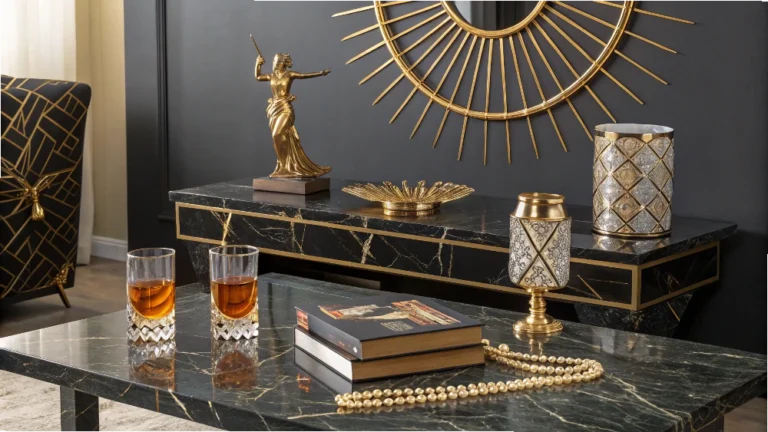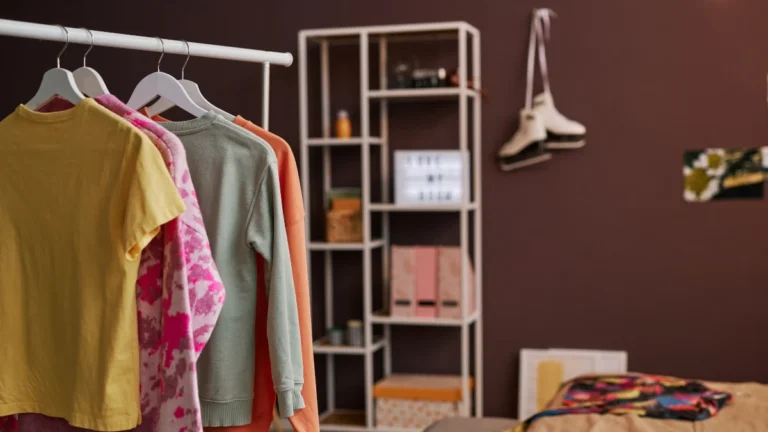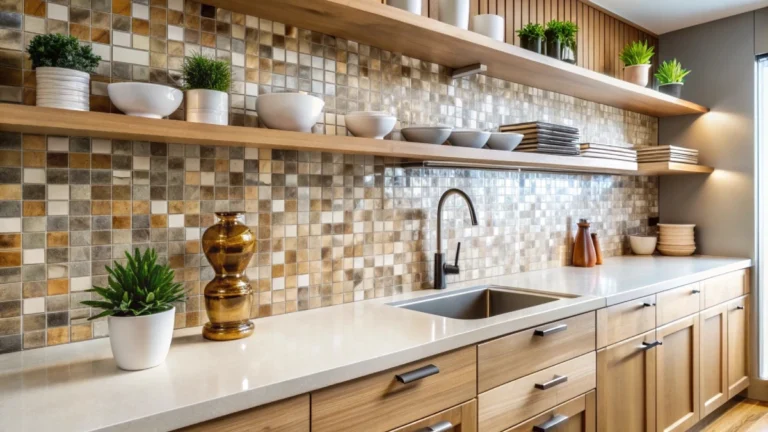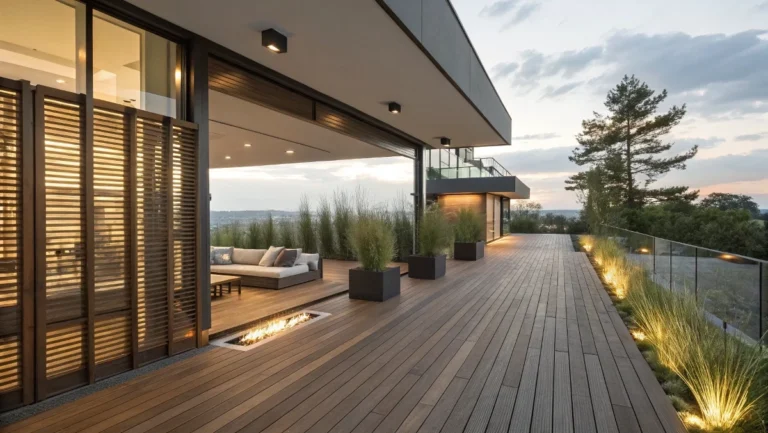17 Indoor Plant Styling Ideas That Aren’t Basic Plant Mom Vibes

Your plants are healthy and thriving, but something’s missing – they look more like a random collection than a curated design element.
Most plant parents focus on keeping their plants alive but struggle with making them look intentionally styled and cohesive within their home decor.
21 specific, actionable styling techniques that work in any space and budget, from beginner-friendly arrangements to advanced design concepts.
4 Plant Styling Mistakes That Ruin Your Home’s Look (And How to Fix Them)
You’ve spent money on beautiful plants. You’ve arranged them carefully around your home. But something still looks off.
Your plant arrangement doesn’t look like those Instagram photos. Instead, it looks messy or random. You’re making common mistakes that most plant parents don’t even know about.
Here are the four biggest styling mistakes that kill your indoor plant displays.
Cramming Too Many Plants Together
The mistake: You think more plants equals better style. So you cluster five plants on one small table or windowsill.
Why it fails: Plants need breathing room. When you crowd them, each plant fights for attention. Nothing stands out. Your eye doesn’t know where to look.
The fix: Use the rule of three. Group three plants of different heights together. Leave space between groups. A tall snake plant, medium pothos, and small succulent work better than seven random plants squeezed together.
Your plants also need air flow. Crowded plants get sick faster. They can’t dry out properly between waterings.
Putting Style Before Light Needs
The mistake: You place your fiddle leaf fig in that perfect corner. It looks amazing there. But the corner gets no natural light.
Why it fails: A dying plant never looks good. No amount of pretty pots can save brown, droopy leaves. Your plant arrangement fails when the plants fail.
The fix: Choose your light first, then your style. Move your plants to spots where they can thrive. Then work on making those spots look good.
Use grow lights if you need them. A healthy plant in decent light beats a dying plant in perfect style.
Mixing Random Pot Sizes and Styles
The mistake: You buy pots one at a time. Each one looks good in the store. But together, they create chaos.
Why it fails: Your eye sees the differences first. The mismatched pots scream louder than the beautiful plants inside them.
The fix: Pick a theme and stick to it. All white pots. All natural materials. All the same shape in different sizes. You can mix textures, but keep the color family similar.
Start with three matching pots in small, medium, and large. Add more pieces that fit the same style.
Forgetting Plants Grow Bigger
The mistake: You arrange your plants based on how they look today. That tiny pothos fits perfectly on your shelf.
Why it fails: In six months, your pothos trails to the floor. Your arrangement looks completely different. Your carefully planned spacing disappears.
The fix: Research mature plant sizes before you arrange them. Leave growing room. Plan for trailing plants to trail. Think about where you’ll move plants as they get bigger.
Your monstera might look lost in that big corner now. But it will fill that space in two years.
Pro tip: Take photos of your arrangements. Check them every few months. Adjust as your plants grow.
The Bottom Line
Great indoor plant styling isn’t about following trends. It’s about avoiding these basic mistakes. Give your plants space, light, and room to grow. Choose pots that work together.
Your plants will look better. They’ll stay healthier. And your home will have that styled look you want.
Start with one area. Fix these mistakes there first. Then move to the next spot. Your plant arrangement will improve with each small change.
1. Layered Natural Textures Plant Display

This stunning arrangement showcases how natural materials can elevate your indoor plant game. A vibrant purple shamrock plant takes center stage in a speckled white ceramic planter. The woven rattan stool beneath creates visual interest while adding height to the display. Natural textures blend seamlessly together, creating depth and warmth in this minimalist corner.
Rattan furniture serves double duty as both functional seating and stylish plant stands. The organic curves of the woven base complement the smooth ceramic pot beautifully. Behind the main display, a fiddle leaf fig adds vertical drama without overwhelming the space. Each element contributes to a cohesive look that feels both intentional and effortless.
Color plays a crucial role in this styling approach. The deep burgundy foliage creates striking contrast against neutral backgrounds and natural wood tones. Light wooden flooring and simple wall colors allow the plants and textures to shine. This arrangement proves that mixing materials like ceramic, rattan, and wood creates visual richness. The result feels organic and inviting, bringing natural beauty indoors through thoughtful plant placement and complementary textures.
2. The Cascading Macrame Plant Wall

Transform any unused corner into a lush vertical garden using macrame plant hangers at varying heights. Multiple trailing plants cascade down the wall, creating a living curtain of greenery. Pothos vines stretch dramatically from ceiling to floor, while spider plants and other varieties fill different levels. This approach maximizes growing space without taking up valuable floor area.
Woven baskets on the ground level complement the rope hangers above, maintaining visual consistency throughout the display. Natural materials like jute and rattan add warmth to the white walls and modern furniture. Small floating shelves provide additional planting opportunities for compact varieties. Each plant occupies its own space while contributing to the overall jungle effect.
Layering plants at different heights creates depth and movement in what was once empty wall space. Natural light from the nearby window nourishes all levels of this vertical arrangement. Floor plants in textured baskets anchor the display and provide weight at the bottom. The result transforms a simple corner into a dramatic focal point that brings life and color to any room. This styling method works especially well in small spaces where floor area is limited.
3. Minimalist Floating Plant Shelf System

Floating wooden shelves create an elegant plant display that turns any blank wall into a living gallery. Multiple levels allow you to showcase various plant types while maintaining a clean, organized appearance. White ceramic planters provide visual consistency across different shelf heights, while the natural wood adds warmth to the neutral palette. This approach works especially well near windows where plants can benefit from abundant natural light.
Different plant varieties find their own space on each shelf level. Trailing plants cascade beautifully from upper shelves, while compact succulents and snake plants occupy lower positions. The arrangement balances height and texture, creating visual interest without appearing cluttered. Books and small decorative items can share shelf space with plants, making the display both functional and beautiful.
Floor level elements anchor the entire arrangement with a statement monstera in a textured basket. Small potted plants line the bottom shelf, creating a foundation for the vertical display above. This styling method maximizes wall space while keeping plants easily accessible for care. The result transforms ordinary shelving into a sophisticated plant showcase that brings life and color to any room while maintaining a modern, minimalist aesthetic.
4. Bathroom Jungle Sanctuary

Transform your bathroom into a lush retreat by combining hanging ferns with natural textures and strategic plant placement. Large Boston ferns cascade from the ceiling, creating a dramatic canopy effect above the freestanding tub. Natural light streaming through expansive windows provides the humidity and brightness these moisture-loving plants crave. This approach turns daily bathing routines into spa-like experiences surrounded by living greenery.
Wooden ladders serve as functional plant stands while adding rustic charm to the space. Woven baskets at various heights house different plant varieties, from snake plants to trailing species. The natural materials complement white subway tiles and create visual warmth against clean bathroom surfaces. Each basket adds texture and organic shapes that soften the geometric lines of traditional bathroom fixtures.
Multiple plant levels create depth and interest throughout the room. Floor plants in large baskets anchor the design while smaller specimens on ladder rungs fill middle spaces. Ceiling-mounted ferns complete the vertical garden effect, making the room feel like an indoor oasis. Soft candlelight enhances the natural ambiance, creating a tranquil environment where plants thrive in bathroom humidity. This styling method proves that bathrooms can become some of the most beautiful plant-filled spaces in your home.
5. Kitchen Herb Garden Window Display

Kitchen Windowsill Herb Garden Station
Create a functional and charming herb display right in your kitchen using a simple wooden tray to corral different containers. Fresh herbs like basil, rosemary, thyme, and mint thrive in this sunny windowsill location where they receive natural light throughout the day. Mason jars and terracotta pots provide variety in container styles while maintaining a cohesive rustic aesthetic. The chalkboard sign adds farmhouse charm while helping identify each herb variety.
Mixing container types creates visual interest in this compact growing space. Terracotta pots wrapped with twine bring texture and warmth, while clear mason jars show off root systems and growing progress. The vintage galvanized watering can serves both decorative and practical purposes, making plant care convenient. Each container works together to create an organized yet organic arrangement.
This styling approach puts fresh ingredients within arm’s reach while cooking. Kitchen herbs benefit from the humidity and warmth generated during meal preparation, creating growing conditions similar to greenhouse environments. The wooden tray keeps everything contained and portable, allowing you to move the entire display when needed. Natural light from the window ensures healthy growth while the arrangement adds living beauty to your culinary workspace.
6. Living Plant Room Divider

Tall metal plant stands serve double duty as both plant displays and subtle room dividers in open floor plans. This black industrial-style shelf unit creates visual separation between living and dining areas without blocking natural light flow. Multiple tiers accommodate plants of varying heights and sizes, from trailing varieties to upright snake plants. The open frame design maintains an airy feeling while adding structure to the space.
Mixing plant types creates visual interest across different shelf levels. Textured planters in various materials complement the sleek metal frame, while different plant shapes add organic contrast to the geometric lines. The tall fiddle leaf fig anchors the entire arrangement from floor level, creating a stunning focal point that draws the eye upward. Each shelf becomes its own mini garden vignette.
This styling approach works especially well in modern homes with high ceilings and open layouts. The vertical display maximizes growing space while maintaining clean sight lines throughout the room. Natural light from nearby windows reaches plants at every level, ensuring healthy growth. Metal finishes coordinate beautifully with contemporary furniture and fixtures, making this plant stand both functional and stylish for today’s living spaces.
7. Vintage Plant Stand Collection

Ornate plant stands elevate your greenery into living art pieces that complement vintage-inspired interiors. This intricately carved pedestal transforms a simple potted plant into an elegant focal point worthy of a Victorian conservatory. Botanical prints create a gallery wall backdrop that enhances the natural theme while adding sophisticated visual interest. The combination of live plants and botanical artwork creates depth and tells a cohesive story about your love of nature.
Multiple height levels prevent the corner from feeling flat or forgotten. The decorative plant stand raises greenery to eye level, while floor plants in textured baskets provide grounding weight below. Natural materials like woven baskets complement the ornate metalwork and create visual balance. Each element works together to transform an ordinary corner into a curated vignette that feels both collected and intentional.
This styling approach works beautifully in traditional or eclectic homes where ornate details are celebrated. The telescope adds an element of curiosity and scientific exploration that pairs naturally with botanical interests. Soft window light illuminates both plants and artwork, creating gentle shadows that enhance the romantic atmosphere. Rich hardwood floors and flowing curtains complete this timeless look that brings Victorian elegance into modern living spaces.
8. Terrarium Coffee Table Garden

Glass terrariums bring miniature garden magic directly to your living room coffee table. These geometric containers showcase tiny succulent landscapes that require minimal maintenance while providing maximum visual impact. Copper-framed pyramid shapes contrast beautifully with round glass bowls, creating an interesting mix of angular and curved forms. Layered sand and pebbles add texture and color depth to each enclosed ecosystem.
Books serve as natural pedestals, creating varying heights that make the arrangement more dynamic and engaging. Stacking volumes of different thicknesses allows each terrarium to occupy its own visual space while contributing to the overall composition. The neutral book covers complement the glass containers without competing for attention. This layering technique transforms a flat coffee table surface into a multi-dimensional display.
Terrariums work exceptionally well in modern and minimalist spaces where clean lines and geometric shapes are celebrated. The enclosed glass environments protect delicate plants while creating fascinating miniature worlds that invite closer inspection. Low maintenance succulents thrive in these controlled conditions, making this styling choice both beautiful and practical. Coffee table arrangements like this become conversation starters that bring natural elements into contemporary living spaces without overwhelming the room’s aesthetic.
9. Industrial Pipe Plant Display

Raw industrial materials transform plant displays into architectural statements that complement loft-style living spaces. This tall metal frame with reclaimed wood shelves creates a striking vertical garden that works beautifully against exposed brick walls and concrete floors. Multiple levels accommodate various plant sizes while the open framework maintains sight lines throughout the space. The combination of black steel and natural wood brings warmth to industrial environments without compromising the urban aesthetic.
Each shelf level houses different plant varieties in coordinating concrete and wooden planters. Snake plants provide vertical structure while trailing varieties add softness to the geometric lines. Wooden planter boxes filled with ornamental grasses create texture and movement. The neutral planter palette allows the greenery to take center stage while maintaining visual cohesion across all levels.
This styling approach works exceptionally well in open floor plans where traditional furniture might feel heavy or overwhelming. The unit serves as both plant display and subtle space divider, creating zones without blocking natural light flow. Industrial pendant lights above provide ambient illumination that complements the plant display below. Modern loft spaces benefit from this type of structured greenery that echoes the building’s architectural bones while softening hard surfaces.
10. Floating Garden Gallery Wall

Wooden shadow boxes create a contemporary living wall that combines plants with artistic flair. Various sized frames house different plant types, from lush moss gardens to trailing ferns and compact succulents. Some boxes function as vertical planters while others serve as display shelves for both plants and decorative objects. The mixed arrangement creates visual rhythm across the entire wall surface while maintaining a cohesive wood-toned aesthetic.
Botanical prints interspersed between the living planters enhance the gallery wall concept. This approach allows you to combine your love of plants with curated artwork, creating a dynamic display that changes as plants grow and seasons shift. The wooden frames unify the entire composition while providing clean lines that work well in modern dining spaces. Each box becomes its own mini exhibition space.
Modern pendant lighting adds another layer of visual interest while providing ambient illumination for both plants and artwork. The textured glass globes echo the organic nature of the living wall while maintaining contemporary sophistication. This styling method transforms a simple dining room into an immersive botanical experience. Wall-mounted planters save floor space while creating maximum visual impact in areas where traditional plant stands might interfere with furniture placement.
11. Greenhouse Display Cabinet Conversion

Transform an antique curio cabinet into a sophisticated plant conservatory that showcases your most prized botanical specimens. This illuminated glass cabinet creates controlled growing conditions while turning rare plants into living museum pieces. Interior lighting highlights each plant’s unique characteristics, from delicate orchids to fascinating carnivorous varieties. The traditional wooden frame adds elegance to any room while protecting sensitive plants from drafts and temperature fluctuations.
Labels identify each specimen, creating an educational element that transforms your plant collection into a curated botanical exhibition. Multiple glass shelves provide optimal viewing angles while allowing light to penetrate every level. The enclosed environment maintains consistent humidity levels that many exotic plants require for healthy growth. This approach works especially well for orchids, air plants, and other specimens that need specific growing conditions.
Cabinet conservatories work beautifully in traditional and eclectic interiors where architectural details are celebrated. The warm wood finish coordinates with existing furniture while the glass panels keep the display feeling open and accessible. Surrounding floor plants create a lush foundation that enhances the entire botanical vignette. This styling method allows you to grow challenging plants successfully while creating a stunning focal point that sparks conversation and admiration from visitors.
12. Staircase Living Plant Cascade

Black cube planters suspended at staggered heights transform ordinary stairwells into dramatic vertical gardens. These geometric containers create visual rhythm while trailing plants cascade downward like living waterfalls. The suspended system maximizes growing space without interfering with foot traffic or handrails. Modern cable systems allow planters to float at various levels, creating depth and movement throughout the vertical space.
Trailing varieties work exceptionally well in this elevated display format. String of pearls, pothos, and ivy create long cascades that soften the angular architecture while adding natural movement to static spaces. The black planters coordinate beautifully with contemporary railings and fixtures, maintaining the sleek aesthetic of modern homes. Each suspended container becomes a sculptural element that contributes to the overall design narrative.
Stairwells often receive excellent natural light from upper windows, making them surprisingly good locations for plant displays. The suspended approach keeps plants elevated where they can access this light while creating stunning visual impact for anyone using the stairs. Floor plants at the base anchor the entire composition and provide additional greenery at ground level. This method transforms transitional spaces into garden experiences that make moving between floors more enjoyable.
13. Suspended Plant Chandelier Statement Piece

Ceiling-mounted light fixtures become extraordinary plant displays when combined with trailing greenery that cascades dramatically downward. This geometric chandelier supports lush ferns and trailing varieties that create a living canopy above the dining table. The metal framework provides structural support while allowing plants to spill naturally through the openings. This approach transforms ordinary lighting into a stunning focal point that serves both illumination and botanical purposes.
Trailing plants work exceptionally well in this elevated position where they can cascade freely without obstruction. String of hearts, pothos, and small ferns create varying textures and lengths that add movement and life to the fixture. The suspended garden draws the eye upward, making dining spaces feel more intimate while maintaining adequate lighting for meals. Chain supports distribute weight evenly while complementing the industrial-chic aesthetic.
This styling method works particularly well in spaces with high ceilings where traditional hanging plants might feel lost or insignificant. The combination of functional lighting with living elements creates a unique conversation piece that guests will remember long after dinner ends. Additional floor and tabletop plants throughout the room create a cohesive botanical theme that feels both sophisticated and organic.
14. Mirror Amplified Plant Wall Gallery

Circular mirrors in varying sizes create a stunning backdrop for layered plant displays that feel both sophisticated and contemporary. This gallery wall approach uses gold-framed mirrors to amplify natural light while reflecting the greenery from multiple angles. The metallic theme continues through textured brass planters and geometric plant stands that coordinate beautifully with the mirror frames. Each reflective surface doubles the visual impact of surrounding plants while creating depth and movement throughout the space.
Height variation keeps the arrangement visually engaging across multiple levels. Floor plants in large textured planters anchor the display, while elevated specimens on metal stands fill middle spaces. The bird of paradise and fiddle leaf fig provide bold architectural shapes that complement rather than compete with the circular mirror arrangement. Brass and gold finishes unify all elements while adding warmth to the neutral color palette.
This styling method works particularly well in modern living spaces where metallic accents are already part of the design vocabulary. The mirrors serve dual purposes by expanding the apparent size of the room while creating interesting visual layers. Natural light bounces between reflective surfaces and plant leaves, creating subtle lighting effects that change throughout the day. The result feels both curated and organic, bringing luxury hotel vibes into residential spaces.
15. Vintage Library Ladder Plant Display

Built-in wooden bookshelves become enchanting garden spaces when trailing plants cascade from upper levels down through book collections. This traditional library design incorporates lush ivy that spills naturally from the highest shelves, creating living curtains alongside leather-bound volumes. Plants nestled between book groupings add organic texture to the structured rows while maintaining the scholarly atmosphere. The rolling ladder provides easy access to both books and plant care needs at various heights.
Vintage galvanized containers at floor level house additional greenery while echoing the rustic charm of the wooden cabinetry. These weathered metal planters complement the traditional aesthetic while providing practical growing space for herbs or compact plants. The mix of terracotta pots and metal containers creates visual variety without disrupting the cohesive color palette. Each plant placement feels intentional yet natural, as if the garden has gradually claimed its space among the books over time.
This approach works beautifully in homes where reading and nature appreciation go hand in hand. The warm wood tones provide a rich backdrop that makes both books and plants appear more vibrant. Natural window light nourishes the plants while creating cozy reading nooks below. The result transforms a traditional library into a living space that celebrates both knowledge and natural beauty.
16. Indoor Window Box Garden System

Tiered growing systems transform sunny windows into productive indoor farms that provide fresh herbs and vegetables year-round. This multi-level setup combines natural window light with LED grow lights to create optimal growing conditions for edible plants. White rectangular planters house everything from leafy greens to cherry tomatoes, bringing the satisfaction of homegrown produce into your kitchen space. The clean, modern design integrates seamlessly with contemporary home aesthetics while maximizing growing potential in limited floor space.
Artificial lighting supplements natural sunlight to ensure consistent plant growth regardless of weather conditions. The adjustable LED fixtures provide full-spectrum light that supports both leafy growth and fruit production. This approach allows you to grow sun-loving crops like tomatoes and peppers even in spaces that might not receive optimal natural light throughout the day. Fresh herbs remain within easy reach for cooking while larger plants like tomatoes add vertical interest and abundant harvests.
This styling method appeals to those who want their plant displays to serve practical purposes beyond decoration. The systematic arrangement creates a mini greenhouse effect that protects plants while showcasing your commitment to sustainable living. Regular harvesting keeps the display looking fresh and productive, making this both a beautiful and functional addition to any bright room.
17. Plant Photography Studio Corner

Open shelving units become living displays when plants share space with books, cameras, and everyday objects. This approach creates an organic, lived-in feeling that feels more natural than formal plant arrangements. Small succulents and trailing varieties nestle between book collections while larger floor plants anchor the corners. The mix of greenery with functional items makes the space feel both productive and nurturing, showing how plants can enhance rather than compete with storage needs.
Each shelf level tells its own story through carefully curated combinations of plants, books, and personal items. Trailing plants add softness to geometric shelf lines while compact varieties like snake plants provide structured vertical elements. The white shelving creates a clean backdrop that allows both plants and objects to stand out clearly. Camera equipment and books suggest this space serves multiple purposes, proving that plant styling can adapt to working environments.
This styling method works exceptionally well for people who want beautiful spaces without sacrificing functionality. Plants become part of the room’s working ecosystem rather than mere decoration. The casual arrangement feels effortless while creating visual interest at multiple levels. Natural light from nearby windows supports plant health while the varied heights and textures create depth throughout the entire wall display.
What plants work best for beginners who want to create stylish indoor displays?
Start with low-maintenance varieties that forgive occasional neglect while still looking impressive in styled arrangements. Snake plants, pothos, and ZZ plants thrive in various lighting conditions and require minimal watering.
These hardy specimens work well in modern planters and can handle the stress of being moved around for styling purposes. Succulents like aloe and jade plants add interesting textures to displays while needing water only when soil feels completely dry.
Peace lilies and rubber trees provide dramatic height and full foliage that makes styling arrangements look intentional and lush. Focus on plants known for their resilience rather than exotic varieties that demand specific care routines. This approach allows you to experiment with different styling ideas without worrying about plant survival.
How do I ensure my plants stay healthy when they’re part of decorative displays?
Consider each plant’s natural light and water requirements before incorporating them into your styling scheme. Trailing plants in hanging displays still need regular watering, so choose locations where you can easily reach them with a watering can or step stool.
Group plants with similar care needs together to streamline maintenance routines. Rotate plants periodically so all sides receive adequate light exposure, especially those positioned against walls or in corners. Use plant saucers under decorative planters to protect furniture while allowing proper drainage.
Check soil moisture regularly since decorative containers may not have drainage holes, requiring more careful watering practices. Monitor plants for signs of stress like yellowing leaves or stunted growth, and be prepared to relocate them to more suitable spots if styling locations prove problematic.
Can I create impressive plant displays on a limited budget?
Focus on propagating plants from friends or existing specimens rather than purchasing expensive mature plants. Pothos, snake plants, and many succulents multiply easily through simple propagation methods, giving you multiple plants from one purchase.
Repurpose household items like baskets, vintage containers, and wooden boxes as planters instead of buying expensive decorative pots. Thrift stores and garage sales often yield unique containers that add character to plant displays at fraction of retail costs.
Start small with a few well-placed plants and gradually expand your collection as budget allows. Trailing varieties give maximum visual impact since they fill more space as they grow, making single plants appear more substantial.
Creative use of height through books, wooden crates, or simple DIY plant stands creates impressive displays without expensive furniture purchases.






